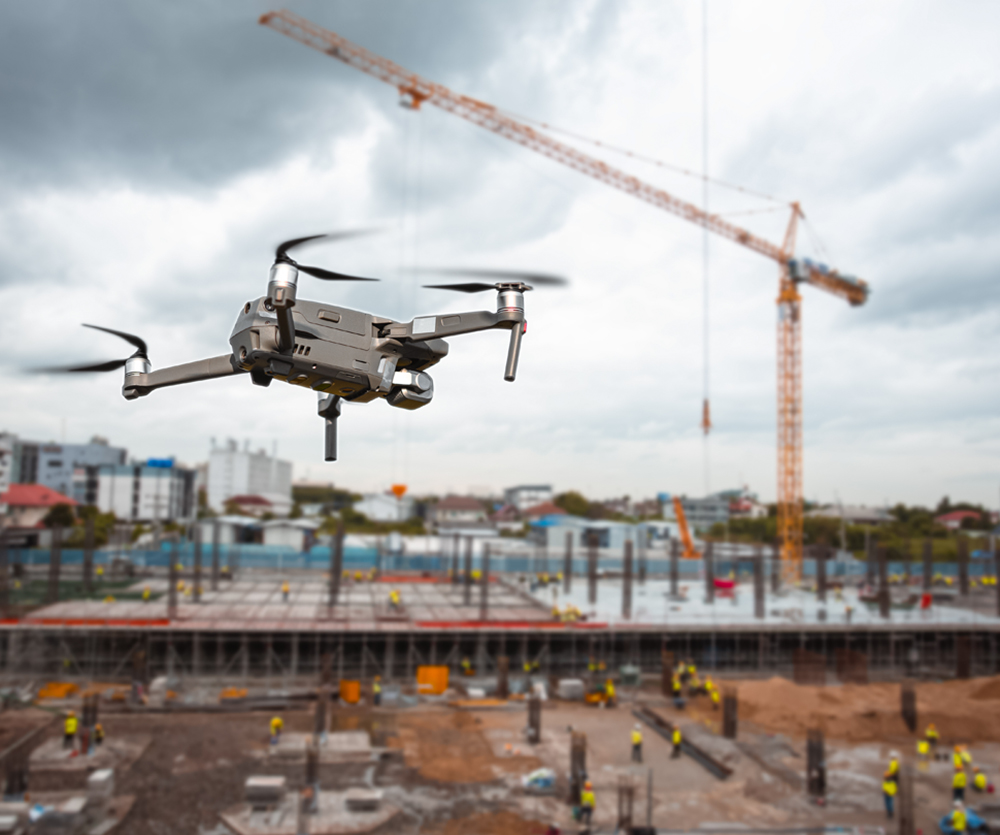Drone technology has been in development for decades, and while using drones in the construction industry is not a new idea, what is remarkable is the rate at which they are being adopted. In 2018, drone usage skyrocketed by 239% for construction applications 1, the highest of any commercial sector.
This is particularly notable because the construction industry has historically been hesitant to incorporate new technologies into traditional methods of operating. According to a report by McKinsey, the annual productivity growth in construction has only increased by 1% every year for the last 20 years 2, a statistic that translates to an enormous amount of wasted time and money for clients and contractors alike.
What Are Drones Used for in Construction?
Enhanced Surveying and Mapping: Perhaps the most obvious use for drones is to survey and map construction sites in the pre-build stage. Modern drones are often equipped with high-resolution cameras and sensors which can capture clear aerial imagery and generate accurate topographic maps and 3D models of construction sites.
Progress Monitoring and Project Management: Monitoring the progress of a development can be challenging, particularly for those who do not work on-site. Drones present an opportunity for clients, project managers and off-site workers to view the site remotely, compare the progress made with the initial construction plans and make informed decisions based on real-time data. This is an invaluable tool for project management as it enables timely adjustments to ensure projects stay on schedule and within budget.
Construction Site Security and Maintenance: According to the Chartered Institute of Building 3, 92% of construction companies are directly affected by petty crime, and 21% claim that they experience theft on a weekly basis. Drones can be used for surveillance and to identify theft or damage to equipment on site. If damage occurs to the site outside of working hours or in extreme weather conditions, drones are useful tools to quickly identify any maintenance issues that need to be addressed.
Structure Inspection: Traditionally, inspecting a structure can require extensive manpower and equipment, particularly for hard-to-reach areas such as rooftops. Drones allow construction companies to conduct comprehensive inspections safely and efficiently and, if equipped with thermal sensors or other upgrades, they can even identify heat leaks, electrical issues, and other flaws in a fraction of the time it would take to do so manually.
What Are the Benefits of Using Drones?
- Boosts efficiency: Surveying a construction site manually is a time-consuming process that involves skill, focus, and a potential for error. An estimated five acres of land can be surveyed per hour using traditional methods, while in comparison, a drone can survey up to 120 acres per hour. The Norwegian Public Roads Administration 4 experienced the benefits of using drones first-hand by using them to survey their road construction sites. The data that would normally take five days in the field to record manually was accomplished in just one hour by using a drone, saving a significant amount of time in the project schedule.
Reduces Costs: Time translates to money in the construction industry, and because of the long hours that are required to survey a site manually, using a drone saves on all the costs of equipment and manpower that would be used instead. Rather than replacing surveyors, however, this technology should be viewed as an opportunity to upskill and learn how digital tools can enhance existing knowledge and experience.
Lowers Risk: Falls account for 50% of construction worker fatalities in the UK 5, and therefore, using a drone where possible in hazardous situations can help to mitigate this risk. Additionally, the aerial views a drone provides can be used to spot potential danger areas in a construction site that can be rectified before an incident occurs.
Improves Data Accuracy: A survey by ProDroneWorx 6 shows that 56% of construction companies use drones for improved data quality. The maps generated by drone data provide accurate measurements of distances, surfaces, elevations, and volumes that eliminate the human error aspect of surveying. Using digital data also gives construction firms an edge over their competitors as they are able to reduce their costs, improve their productivity, and increase their accuracy.
As their applications continue to diversify, the technology for drones is advancing swiftly to keep up with demand. Companies like Kaizen Aerospace 7 are leading the way by creating new variations of drones that are tailored for use in certain industries, such as construction, emergency services, or transport. Their xFold Dragon series drones, for instance, can be purchased with specific upgrades to suit the customers’ requirements, i.e., longer flight times or heavy lift capabilities of up to 1,000 lbs.
With the recent AI boom, it is also likely that in the near future AI and machine learning will become integrated into drone technology, allowing them to perform complex tasks on their own with very little human interference.
Drone technology is quickly becoming more sophisticated, and we can expect their contributions to the construction sector to increase significantly, a step that will undoubtedly improve the efficiency, productivity, and safety of the industry.
Author: Shirley Carruthers - Content Creator at ParkerSteel
References:
DroneDeploy Blog - Rise of Drones in Construction
McKinsey - Reinventing Construction through a Productivity Revolution (PDF)
Prime Secure - Crime in the Construction Industry (PDF)
Wingtra - Road Surveys with VTOL Drone Data
Health and Safety Executive (HSE) - Construction Statistics (PDF)
ProDroneWorx
Kaizen Aero

